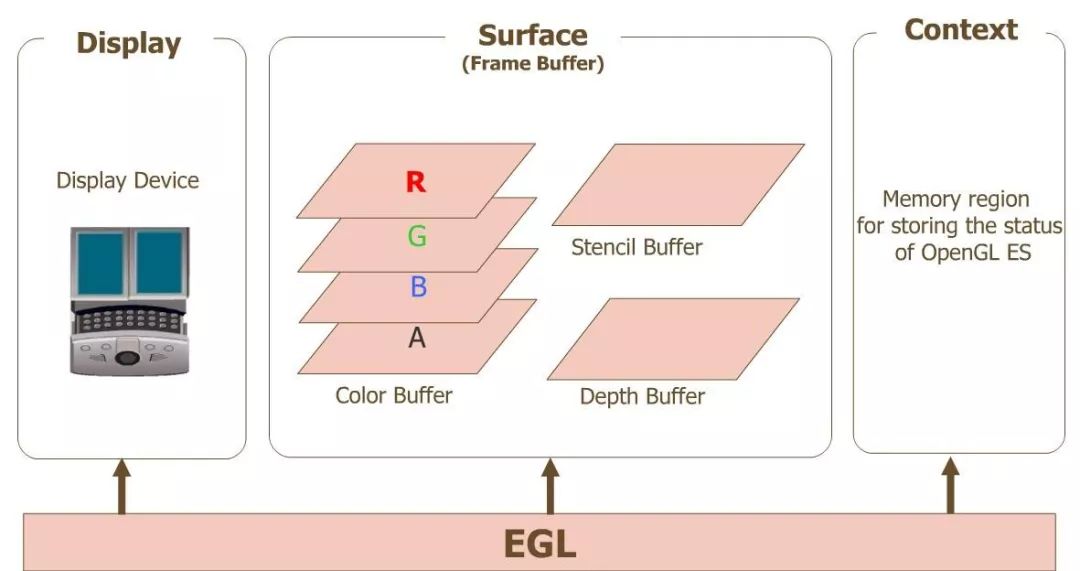![]()
什么是 EGL
EGL 是 OpenGL ES 和本地窗口系统(Native Window System)之间的通信接口
,它的主要作用:
OpenGL ES 的平台无关性正是借助 EGL 实现的,EGL 屏蔽了不同平台的差异(Apple 提供了自己的 EGL API 的 iOS 实现,自称 EAGL)。
本地窗口相关的 API 提供了访问本地窗口系统的接口,而 EGL 可以创建渲染表面 EGLSurface ,同时提供了图形渲染上下文 EGLContext,用来进行状态管理,接下来 OpenGL ES 就可以在这个渲染表面上绘制。
![]()
egl、opengles 和设备之间的关系
图片中:
Display(EGLDisplay) 是对实际显示设备的抽象;
Surface(EGLSurface)是对用来存储图像的内存区域 FrameBuffer 的抽象,包括 Color Buffer(颜色缓冲区), Stencil Buffer(模板缓冲区) ,Depth Buffer(深度缓冲区);
Context (EGLContext) 存储 OpenGL ES 绘图的一些状态信息;
在 Android 平台上开发 OpenGL ES 应用时,类 GLSurfaceView 已经为我们提供了对 Display , Surface , Context 的管理,即 GLSurfaceView 内部实现了对 EGL 的封装,可以很方便地利用接口 GLSurfaceView.Renderer 的实现,使用 OpenGL ES API 进行渲染绘制,很大程度上提升了 OpenGLES 开发的便利性。
当然我们也可以自己实现对 EGL 的封装,本文就是在 Native 层对 EGL 进行封装,不借助于 GLSurfaceView ,实现图片后台渲染,利用 GPU 完成对图像的高效处理。
EGL 的应用
![]()
EGL 后台渲染实现效果图
使用 EGL 渲染的一般步骤:
-
获取 EGLDisplay 对象,建立与本地窗口系统的连接
调用 eglGetDisplay 方法得到 EGLDisplay。
-
初始化 EGL 方法
打开连接之后,调用 eglInitialize 方法初始化。
-
获取 EGLConfig 对象,确定渲染表面的配置信息
调用 eglChooseConfig 方法得到 EGLConfig。
-
创建渲染表面 EGLSurface
通过 EGLDisplay 和 EGLConfig ,调用 eglCreateWindowSurface 或 eglCreatePbufferSurface 方法创建渲染表面,得到 EGLSurface,其中 eglCreateWindowSurface 用于创建屏幕上渲染区域,eglCreatePbufferSurface 用于创建屏幕外渲染区域。
-
创建渲染上下文 EGLContext
通过 EGLDisplay 和 EGLConfig ,调用 eglCreateContext 方法创建渲染上下文,得到 EGLContext。
-
绑定上下文
通过 eglMakeCurrent 方法将 EGLSurface、EGLContext、EGLDisplay 三者绑定,绑定成功之后 OpenGLES 环境就创建好了,接下来便可以进行渲染。
-
交换缓冲
OpenGLES 绘制结束后,使用 eglSwapBuffers 方法交换前后缓冲,将绘制内容显示到屏幕上,而屏幕外的渲染不需要调用此方法。
-
释放 EGL 环境
绘制结束后,不再需要使用 EGL 时,需要取消 eglMakeCurrent 的绑定,销毁 EGLDisplay、EGLSurface、EGLContext 三个对象。
代码实现:
// 创建 GLES 环境
int BgRender::CreateGlesEnv()
{
// EGL config attributes
const EGLint confAttr[] =
{
EGL_RENDERABLE_TYPE, EGL_OPENGL_ES3_BIT_KHR,
EGL_SURFACE_TYPE,EGL_PBUFFER_BIT,//EGL_WINDOW_BIT EGL_PBUFFER_BIT we will create a pixelbuffer surface
EGL_RED_SIZE, 8,
EGL_GREEN_SIZE, 8,
EGL_BLUE_SIZE, 8,
EGL_ALPHA_SIZE, 8,// if you need the alpha channel
EGL_DEPTH_SIZE, 8,// if you need the depth buffer
EGL_STENCIL_SIZE,8,
EGL_NONE
};
// EGL context attributes
const EGLint ctxAttr[] = {
EGL_CONTEXT_CLIENT_VERSION, 2,
EGL_NONE
};
// surface attributes
// the surface size is set to the input frame size
const EGLint surfaceAttr[] = {
EGL_WIDTH, 1,
EGL_HEIGHT,1,
EGL_NONE
};
EGLint eglMajVers, eglMinVers;
EGLint numConfigs;
int resultCode = 0;
do
{
//1. 获取 EGLDisplay 对象,建立与本地窗口系统的连接
m_eglDisplay = eglGetDisplay(EGL_DEFAULT_DISPLAY);
if(m_eglDisplay == EGL_NO_DISPLAY)
{
//Unable to open connection to local windowing system
LOGCATE("BgRender::CreateGlesEnv Unable to open connection to local windowing system");
resultCode = -1;
break;
}
//2. 初始化 EGL 方法
if(!eglInitialize(m_eglDisplay, &eglMajVers, &eglMinVers))
{
// Unable to initialize EGL. Handle and recover
LOGCATE("BgRender::CreateGlesEnv Unable to initialize EGL");
resultCode = -1;
break;
}
LOGCATE("BgRender::CreateGlesEnv EGL init with version %d.%d", eglMajVers, eglMinVers);
//3. 获取 EGLConfig 对象,确定渲染表面的配置信息
if(!eglChooseConfig(m_eglDisplay, confAttr, &m_eglConf, 1, &numConfigs))
{
LOGCATE("BgRender::CreateGlesEnv some config is wrong");
resultCode = -1;
break;
}
//4. 创建渲染表面 EGLSurface, 使用 eglCreatePbufferSurface 创建屏幕外渲染区域
m_eglSurface = eglCreatePbufferSurface(m_eglDisplay, m_eglConf, surfaceAttr);
if(m_eglSurface == EGL_NO_SURFACE)
{
switch(eglGetError())
{
case EGL_BAD_ALLOC:
// Not enough resources available. Handle and recover
LOGCATE("BgRender::CreateGlesEnv Not enough resources available");
break;
case EGL_BAD_CONFIG:
// Verify that provided EGLConfig is valid
LOGCATE("BgRender::CreateGlesEnv provided EGLConfig is invalid");
break;
case EGL_BAD_PARAMETER:
// Verify that the EGL_WIDTH and EGL_HEIGHT are
// non-negative values
LOGCATE("BgRender::CreateGlesEnv provided EGL_WIDTH and EGL_HEIGHT is invalid");
break;
case EGL_BAD_MATCH:
// Check window and EGLConfig attributes to determine
// compatibility and pbuffer-texture parameters
LOGCATE("BgRender::CreateGlesEnv Check window and EGLConfig attributes");
break;
}
}
//5. 创建渲染上下文 EGLContext
m_eglCtx = eglCreateContext(m_eglDisplay, m_eglConf, EGL_NO_CONTEXT, ctxAttr);
if(m_eglCtx == EGL_NO_CONTEXT)
{
EGLint error = eglGetError();
if(error == EGL_BAD_CONFIG)
{
// Handle error and recover
LOGCATE("BgRender::CreateGlesEnv EGL_BAD_CONFIG");
resultCode = -1;
break;
}
}
//6. 绑定上下文
if(!eglMakeCurrent(m_eglDisplay, m_eglSurface, m_eglSurface, m_eglCtx))
{
LOGCATE("BgRender::CreateGlesEnv MakeCurrent failed");
resultCode = -1;
break;
}
LOGCATE("BgRender::CreateGlesEnv initialize success!");
}
while (false);
if (resultCode != 0)
{
LOGCATE("BgRender::CreateGlesEnv fail");
}
return resultCode;
}
//渲染
void BgRender::Draw()
{
LOGCATE("BgRender::Draw");
if (m_ProgramObj == GL_NONE) return;
glViewport(0, 0, m_RenderImage.width, m_RenderImage.height);
// Do FBO off screen rendering
glUseProgram(m_ProgramObj);
glBindFramebuffer(GL_FRAMEBUFFER, m_FboId);
glBindVertexArray(m_VaoIds[0]);
glActiveTexture(GL_TEXTURE0);
glBindTexture(GL_TEXTURE_2D, m_ImageTextureId);
glUniform1i(m_SamplerLoc, 0);
if (m_TexSizeLoc != GL_NONE) {
GLfloat size[2];
size[0] = m_RenderImage.width;
size[1] = m_RenderImage.height;
glUniform2fv(m_TexSizeLoc, 1, &size[0]);
}
//7. 渲染
GO_CHECK_GL_ERROR();
glDrawElements(GL_TRIANGLES, 6, GL_UNSIGNED_SHORT, (const void *)0);
GO_CHECK_GL_ERROR();
glBindVertexArray(GL_NONE);
glBindTexture(GL_TEXTURE_2D, GL_NONE);
//一旦解绑 FBO 后面就不能调用 readPixels
//glBindFramebuffer(GL_FRAMEBUFFER, GL_NONE);
}
//释放 GLES 环境
void BgRender::DestroyGlesEnv()
{
//8. 释放 EGL 环境
if (m_eglDisplay != EGL_NO_DISPLAY) {
eglMakeCurrent(m_eglDisplay, EGL_NO_SURFACE, EGL_NO_SURFACE, EGL_NO_CONTEXT);
eglDestroyContext(m_eglDisplay, m_eglCtx);
eglDestroySurface(m_eglDisplay, m_eglSurface);
eglReleaseThread();
eglTerminate(m_eglDisplay);
}
m_eglDisplay = EGL_NO_DISPLAY;
m_eglSurface = EGL_NO_SURFACE;
m_eglCtx = EGL_NO_CONTEXT;
}
Java 层的代码,主要是一个 ImageView 用于展示渲染前后的图像。
// 创建渲染对象
NativeBgRender mBgRender = new NativeBgRender();
// 初始化创建 GLES 环境
mBgRender.native_BgRenderInit();
// 加载图片数据到纹理
loadRGBAImage(R.drawable.java, mBgRender);
// 离屏渲染
mBgRender.native_BgRenderDraw();
// 从缓冲区读出渲染后的图像数据,加载到 ImageView
mImageView.setImageBitmap(createBitmapFromGLSurface(0, 0, 421, 586));
// 释放 GLES 环境
mBgRender.native_BgRenderUnInit();
private void loadRGBAImage(int resId, NativeBgRender render) {
InputStream is = this.getResources().openRawResource(resId);
Bitmap bitmap;
try {
bitmap = BitmapFactory.decodeStream(is);
if (bitmap != null) {
int bytes = bitmap.getByteCount();
ByteBuffer buf = ByteBuffer.allocate(bytes);
bitmap.copyPixelsToBuffer(buf);
byte[] byteArray = buf.array();
render.native_BgRenderSetImageData(byteArray, bitmap.getWidth(), bitmap.getHeight());
}
}
finally
{
try
{
is.close();
}
catch(IOException e)
{
e.printStackTrace();
}
}
}
private Bitmap createBitmapFromGLSurface(int x, int y, int w, int h) {
int bitmapBuffer[] = new int[w * h];
int bitmapSource[] = new int[w * h];
IntBuffer intBuffer = IntBuffer.wrap(bitmapBuffer);
intBuffer.position(0);
try {
GLES20.glReadPixels(x, y, w, h, GLES20.GL_RGBA, GLES20.GL_UNSIGNED_BYTE,
intBuffer);
int offset1, offset2;
for (int i = 0; i < h; i++) {
offset1 = i * w;
offset2 = (h - i - 1) * w;
for (int j = 0; j < w; j++) {
int texturePixel = bitmapBuffer[offset1 + j];
int blue = (texturePixel >> 16) & 0xff;
int red = (texturePixel << 16) & 0x00ff0000;
int pixel = (texturePixel & 0xff00ff00) | red | blue;
bitmapSource[offset2 + j] = pixel;
}
}
} catch (GLException e) {
return null;
}
return Bitmap.createBitmap(bitmapSource, w, h, Bitmap.Config.ARGB_8888);
}
EGL 后台渲染实现代码路径见阅读原文。









